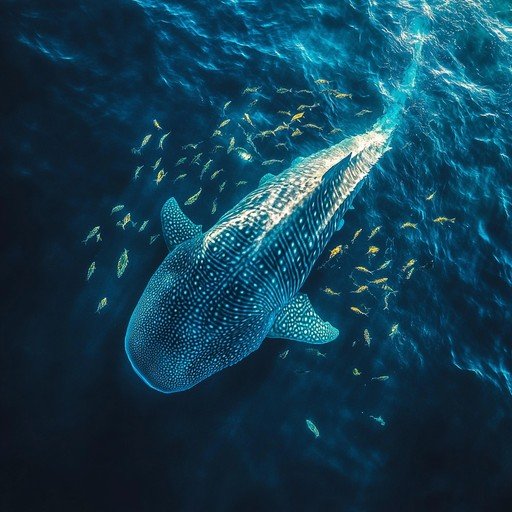
Most people think of sharks as fierce predators, but whale sharks are unique. They mainly feast on tiny plankton and are truly gentle giants. Understanding how they navigate and communicate sheds light on their behavior and helps us appreciate these creatures even more. Let’s dive into their world and explore the secrets of how whale sharks move through the ocean and connect with each other.
The Whale Shark’s Sense of Navigation
Whale sharks have a remarkable ability to navigate the vast ocean, and it all starts with their keen sense of smell. Imagine being able to detect food from miles away, even in murky waters. Whale sharks can do just that! Their nostrils, located on the underside of their heads, allow them to pick up scent particles in the water. This sense plays a crucial role in finding food and mates.
Another way these fish navigate is through their instinctive behavior. They often follow currents and tides, which help them migrate to areas rich in food. During specific times of the year, these sharks travel long distances, sometimes thousands of miles! It’s like they have an internal GPS guiding them. This migratory pattern is essential for their feeding habits and breeding cycles.
Using Environmental Cues
Environmental cues are another vital part of how whale sharks navigate. They can sense changes in water temperature, salinity, and even pressure, which can signal the presence of food sources or suitable habitats. Think of it as listening to the ocean’s whispers. These cues help them make decisions about where to swim and when to forage.
For example, whale sharks often gather at specific sites during plankton blooms. These areas, rich in nutrients, serve as feeding grounds, and the sharks know when to show up. Their ability to adapt to changing environmental conditions ensures their survival in the ocean.
The Role of Echolocation
Echolocation is a fascinating tool that some marine animals, like dolphins and bats, use to navigate. While whale sharks don’t use echolocation in the same way, they do rely on other sonic cues in the water. Sounds from the environment and other marine creatures can help them understand their surroundings.
When underwater, sound travels faster than light, allowing whale sharks to detect distant noises. This sense of hearing helps them avoid predators and find potential mates. It’s like a hidden map, guiding them through their underwater world.
Body Language and Communication
Whale sharks communicate primarily through body language. When swimming together, they display different behaviors that convey messages. For instance, if a whale shark tilts its body or swims in circles, it could be indicating excitement or curiosity.
You might be wondering how they signal to each other in such a vast space. Their large size allows them to move in ways that catch the attention of other shark peers. During social interactions, they may engage in playful behavior, like swimming in synchronized patterns. This kind of interaction creates bonds between individuals and enhances their social structure.
Visual Signals
Besides body movements, whale sharks also use visual signals to communicate. Their unique coloration and patterns act as identifiers. Just like a fingerprint, each whale shark has a distinctive arrangement of spots and stripes. This uniqueness might help them recognize one another, especially during seasonal gatherings.
When they find themselves in close proximity, the visual signals they display can indicate their mood. A relaxed whale shark may swim slowly and gracefully, while an excited one might dart around more energetically.
How They Adapt to Different Environments
Whale sharks are found in warm, tropical oceans. However, they are highly adaptable creatures. Their ability to adjust to varying environments plays a significant role in their navigation and communication. For example, when they move into cooler waters, they may change their swimming patterns or depths to maintain their comfort levels.
In addition to swimming deeper or shallower, they might alter their feeding strategies depending on the environment. If the visibility is low, they may rely more on their sense of smell to find food. Adaptability is key to their success, allowing them to thrive in different ocean habitats.
The Impact of Human Activity
As we learn more about how whale sharks navigate and communicate, it’s essential to consider the impact of human activity on their behavior. Fishing, pollution, and climate change can disrupt their natural habits. For instance, overfishing can deplete their food sources, making it harder for them to navigate to feeding grounds.
Moreover, boat traffic can interfere with their communication tactics. Loud noises from engines can drown out the subtle sounds they rely on for interaction. Unfortunately, this disruption can lead to stress and affect their social dynamics.
Conservation and Awareness
Understanding how whale sharks navigate and communicate can help us advocate for their conservation. The more we know about their behaviors, the better we can protect their habitats and ensure their survival. Efforts like establishing marine protected areas help reduce human interference and allow whale sharks to thrive in their natural environment.
Education plays a crucial role in raising awareness about these gentle giants. By sharing information on their navigation and communication strategies, we can inspire others to appreciate and protect them.
Whale sharks are incredible creatures with unique ways of navigating and communicating in the vast oceans. Through their keen senses, intuitive behaviors, and social interactions, they thrive in their underwater world. By understanding their methods, we can better appreciate how these gentle giants adapt to their environments and the challenges they face due to human activity.
Let’s celebrate and protect whale sharks for future generations. As we learn more about their lives, we not only gain insight into these magnificent creatures but also reinforce the importance of preserving our oceans and the wonders they hold.

